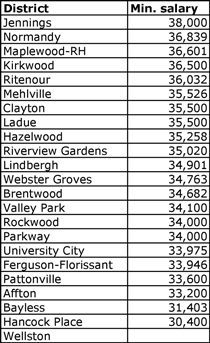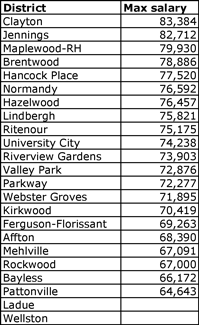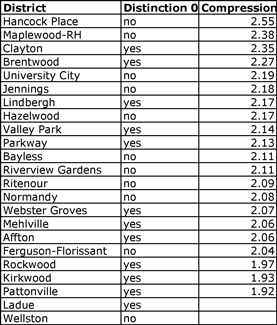Teachers should teach, not be police
Visit NBCNews.com for breaking news, world news, and news about the economy
The Sandy Hook massacre inside an elementary school has shocked us all. While we want everyone to be safe, we expect our youngest to be so inside their own school.
My children attend Clayton School District, one of the wealthier districts in St. Louis County. Like many local districts, it already has police officers at the high school and middle school. On Monday when I went to pick up my youngest, I saw a different police officer at the elementary school. I was a bit taken aback but assumed he was there to help parents feel more secure in the first few days after the Connecticut shooting. I am hopeful that the district does not spend money to keep police officers or even armed security at the elementary schools long-term as the expense would not be justified.
Other school districts such as Kirkwood and Florissant are considering police officers at elementary schools in their school safety reviews. I believe, however, that time and calm parents will help them spend limited resources wisely.
I do agree that schools should review safety procedures as they have after each school shooting and periodically otherwise. Safety experts learn from each experience. For example, whoever turned on the intercom at Sandy Hook, whether intentionally or not, alerted the teachers to the severity of the problem. These types of details are important to safety plans.
St. Louis County Police Chief Tim Fitch said that each officer costs a district about $50,000 for a nine month contract. (Really a 10-month contract) In order to afford that, the district would need to lay off a teacher at each elementary school. That is not a trade-off I am willing to make.
As an alternative to paying for police officers at the schools, some politicians such as Texas governor, Rick Perry, have advocated arming teachers as a way to make schools safer. On Sunday, Chief Fitch brought the gun control debate squarely to the St. Louis school districts.

The St. Louis Post-Dispatch followed up with a front-page story discussing Fitch's suggestion and other security possibilities. The local districts did not react with enthusiasm.
Fred Crawford, chief of security for the Parkway School District, said he would favor more police in schools over gun training for school officers.
The districts are right to hesitate. Teachers with guns in the classroom, even in a locked drawer, would bring a whole new set of problems to schools. That gun is more likely to be found and used against the teacher or other students, the teacher is not going to be as experienced as an active police officer, that gun is unlikely to be useful against a prepared killer like Adam Lanza with a bulletproof vest on, the teacher would be spending time helping students to safety, police might mistake teacher for intruder etc. I would not send my kids to school with a teacher carrying a gun or with a gun in a locked drawer in the classroom. If the gun is locked up in the office, I would still feel uncomfortable. Who would have access? Have the parents been notified who has access? Their training? The date and continuation of their training?
In addition, districts hire teachers to teach, not to act as security.
"I'm a former teacher and my daughter teaches currently. I want our teachers to be trained so that we can address the problems of literacy, so that we can improve our education system. Let the public safety people handle these other issues." --Rep. John Larson (D) Conn. on NOW with Alex Dec. 17, 2012
Districts should re-evaluate their safety plans and assess whether to add more security, depending on the local needs, not as an emotional reaction to a horrific situation. They should not, however, ask teachers to become that security force.
Olympics? Who needs it—we landed the Robotics Championship!
Congrats St. Louis—new home of the cool geeks.
Rhyme or reason to salary schedules?

The St. Louis Post-Dispatch provided an interesting graphic to accompany its Rod Jetton story which gave the district paying the most to beginning teachers and the district paying the least. I had assumed that Clayton would be the highest paying school, but I was wrong. Jennings. The lowest-paying district is Hancock Place. I wasn't surprised there. I ranked all of the districts and could discern no obvious pattern.
I wondered if Jennings was one of those districts that encourages beginning teachers by paying them well but doesn't reward its more experienced and educated teachers, so I also looked at maximum teacher salaries. Nope, Jennings is just a high-paying district.
I wondered if the maximum salary was tied to the median income level of the district. Seemed reasonable that the districts in wealthier areas would pay more. With a correlation number of -.26 though, that's not the case. Other market factors are in play.
The spread between minimum and maximum salaries is important as teachers want to know that their salaries will increase. Quality Counts suggests a ratio of at least 2.0 The St. Louis districts do that to stay competitive even if the rest of the state does not (state average 1.66).
❝In fact, the salaries and career potential for teachers are remarkably flat: The average maximum salary that a teacher can earn is just 1.85 times the salary of a raw entrant, according to the National Center for Education Statistics, based on figures from the 2003-04 school year.❞
To get a better grip on which districts tighten their salary schedules, I ranked them and included whether each district has been named a district of distinction by Missouri based on MAP data.

With Rockwood, Kirkwood and Pattonville the only districts under the 2.0 and on the bottom of the heap, I have to say that the compression ratio isn't the end all although I do think it's important. Studying all the districts of the state might show more of a difference rather than within a region or market area.
I ran some correlation numbers to try to figure out whether the compression ratio is more highly correlated to the maximum salary or the minimum.
Max. salary correlation .73
Min. salary correlation .24
Obviously it is tied to the max salary. Hancock Place did have the highest ratio with a low starting salary and high maximum salary. I was glad to see that the bad press it has received for its low starting salary isn't justified. Most of the time, however, low starting salaries meant little in terms of the ratio.
Summary
I doubt few prospective teachers compare salary schedules too closely as long as a district is within the regional norm, but I found it fascinating. Some of my assumptions were challenged, which will encourage me to dig deeper in the future.
Numbers from MSTA's salary schedule report
We're a great place to educate our kids, so sayeth Forbes

Unlike CQ Press's crime statistics, Forbes seems to realize that St. Louis is more than just the city. In ranking the St. Louis area #9 for best places for education, David Savageau has looked at the entire metropolitan area.
Grades
Public School Support A
Private School Options A+
Library Popularity C+
College Town B+
College Options A+
I find the lower grade for library popularity intriguing as I've always heard St. Louis had a strong library system. I'll have to look into this further. Where are the weak links? I don't have time this Christmas vacation to do much digging as I am busy catching up with my reading and paying those library fines.